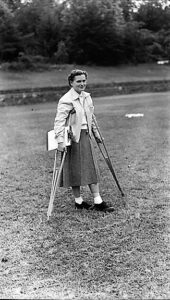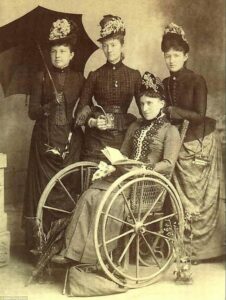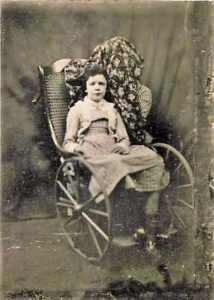Disability and Feminism The Evergreen: A Northern Seasonal
© Copyright 2019 Jonathan McLemore, Ryerson University
Disability and Feminism
The Evergreen: A Northern Seasonal

Introduction
From Volume 1 of “The Evergreen: A Northern Seasonal“, the story of “An Evening in June” by Gabriel Setoun functions as a tale of disability through feminist identity as depicted in late nineteenth century Victorian literature. The author, Gabriel Setoun, goes by a pseudonym that Thomas Nicoll Hepburn opted for in most of his writing. Hepburn appears several times in The Evergreen as a well-known Scottish poet. Being a poet, Hepburn makes use of romantic language through the lens of an old, crippled woman, which will be explored later in this exhibit. The story begins with Janet Balfour, a single woman living in the rural Scottish land. Her days mainly revolve around taking care of the house and being reminiscent of her childhood. The tale draws on how she meets her longtime friend named Alex, and how she awaits his visit in the present day. With her affectionate longing, the audience can assume a romantic interest exists. However, after she reconnects with Alex, it’s revealed that he’s engaged with another woman he met when he left the city years before. In suspense, Janet kisses Alex while he’s off-guard and leaves the story there. By taking the chance to confess her feelings by kissing him, Janet displays direct agency for the first time whereas throughout the story, she’s shown to exist restricted to the village due to her disability. This act of disability and agency is something uncommon in late Victorian era, and draws on the modern romanticized “disabled hero” narrative. With a sense of fascination with this glorified concept, it becomes apparent that Victorians love a fair amount of sentiment, especially when communicated through forms of art like literature.
Romanticizing Disability Literature
In order to draw where Gabriel Setoun’s story rests amongst nineteenth century literature at the time, significance remains in how romanticized disability literature truly was. Martha Stoddard Holmes has a structured analysis titled “Fictions of Affliction: Physical Disability in Victorian Culture”. The book draws on numerous stories that follow suit with the theme of melodrama and the elements required to make such a text worth reading in the eyes of the general public. One of the most focal points of a melodrama is the use of excess emotional appeal, especially those that are alloys-or rather, tools for inspiration (17). This is where disability finds its comfort in literature best; excessively emotional for the purpose of inspiration. However, it is important to understand that disability, being a narrative that is different than the common individual, has its innate nature to be one that should bring about readers. As seen through the monopoly of theaters, stories have saturated the audiences for ages, rendering power of storytelling and dramatic interplay a prerequisite for tickets or book sales (Holmes 23). When it comes to the popularity of romance and the poetical fascination that came with theater profits, it can become rational that combining the two narratives would result in a favorably economic return. With this, Gabriel Setoun chose to have his piece in “The Evergreen: A Northern Seasonal”, which consisted of several romanticized stories alike. Patrick Geddes, being largely involved in the founding and contribution to the publication itself, casually put a few of his pieces in as well. The themes of biology and nature with poetically eloquent descriptions of love and its human participants interacting with that very nature is something the publication is riddled with. Geddes piece of “Life and Its Science” depicts several artistic elements of nature, drawing on the experimental individual and their botanical garden that evolves into this integration with the pulse of a city (29). The paralleled romanticizing of one’s identity with their interaction to society, much like the gardener and their plants, is seen with the disabled individual and their perceived capacity to be more. The term “disability” has connotations that imply a sense of a deficit, as if a disabled individual is now lesser than someone that is not. This connotation stems from years of perceived inferiority and lack of education when it comes to navigating the different realities that disabled people face. Whether that be paralysis or an elaborate mental illness that can extend into psychosis, every lived experience is relative.

Feminist Lens
Feminist scholarship suggests that the relativity in disabled feminist studies is more than just a need for political involvement but rather cultural in its influence (Garland-Thomson). Several scholars have given late nineteenth century Victorian literature a thorough evaluation when it comes to the depiction of disability through feminist lens. One scholar in particular is Martha Stoddard Holmes, author of “Fictions of Affliction: Physical Disability in Victorian Culture”. Holmes explores the various perceptions of disability and romantic relations within the perceptive nature of the men, women and children, and she does this by drawing on the concept of melodrama. This essentially is described as a character theme that expresses an exaggeration that would appeal to emotions, particularly for the purpose of “cranking open feelings” (3). This is meant to draw on the understanding that societal representation (or rather presentation, given its exaggerated nature) of disability is implied to be that of inspiration rather than just a normality. This can be further understood in the Special Olympics where people that have an intellectual disability, cognitive delay, or a developmental disability (Special Olympics Canada) would compete in their own version of the Olympics. Jonathan Weiss draws on research data that suggests that self-worth has a positive correlation with how well they perform (292). This is attributed to the statistical analysis of self-worth and perceived intelligence, which also feeds into one’s capacity to achieve something that’s as great as an Olympic medal. The concept that perceived intelligence largely contributing to a disabled individual’s self-worth is sensibly consistent with Gabriel Setoun’s “An Evening in June”. Being a story that takes place in a state of reminiscence rather than explicit regret, Janet finds her self-worth through Emerson’s essays and learning about the world outside of her hometown. However, being paralyzed, she is still anchored to the reality of her world, which creates a bittersweet undertone.
Nonetheless, one might assume this is simply a portrayal of feminist identity. Garland-Tomson puts forth the notion that femininity in its innate nature is considered a natural form of physical and mental deficiency (Vol 30 no 2). This was under the basis of physical inferiority and an extensive amount of time spent on subjugating women wherever seen fit. For example, C. Kirk Hutson published an article to the Journal of Women’s History that deconstructed the violence towards women in nineteenth-century southern folk music. The article discusses several songs that glorify an acceptance of beating wives and allowing interpersonal violence against women, which is expressive of psychological aggression towards those exact women culturally (Hutson 116). However, It becomes apparent that Victorian literature at the time still represented men in a rough light as well. This is described when late nineteenth century Utopian fiction literature experienced an empowering rise in feminism perspective, where an interest in eugenics lead Mary E. Bradley Lane’s Mizaora concept of eliminating men after asexual reproduction is developed (Lake 1277). Regardless, men and women alike faced complicated critical representations within Victorian literature in the context of the relationships they share.
The Function of Sentiment

When it comes to the politics of sentiment and culture, Glenn Hendler makes a distinct commentary on what it means to “feel right” about someone else’s suffering and to what degree of action is actually available for the reader. Being able to identify with a disabled person’s limitations and respond morally is considered the bare minimum, which consequently leaves nothing else but inspiration as an available choice as culturally practiced. However, this is still on the basis of a disconnect. It is because of the fact disabled people are considered an Other that having emotions of sentiment are not difficult to create. Hendler comments on the limitations of sympathy in another journal published in response to Lousia May Alcott and the sentimental novel, which draws on the elements of feminist narratives that utilize similar sentiment and sympathy tropes. The concept of a heroine departing from her home because “no one understands her” is an absence of sympathy, which is not too uncommon in Victorian literature (Hendler 687). Being Other-oriented allows Gabriel Setoun to illustrate the narrative’s perspective of being different in that her limp implied Janet was once able to walk and lost her ability through being paralyzed (118). This is where it becomes apparent that sentiment drives the reader to sympathize and advance the plot in such a tone that keeps the reader in accordance with Janet, the protagonist, rather than having any emotional compassion for Alex or his fiancé.
Conclusion
Through the use of romanticizing nature, Victorian literature draws on emotional appeal in the context of securing an audience to sell to while also discussing matters that concern that exact audience. Feminist representation through the scope of disability functions as a niche outlet, facilitating a bigger picture of consumption for Victorian people in the nineteenth century. “The Evergreen: A Northern Seasonal” enables this consumer-centric view by using Gabriel Setoun’s “An Evening in June” alongside Patrick Geddes other selections in the publication. For a magazine to consist of such a number of stories and experiences that an audience can find themselves in is one that’s a feat from simple, yet had been achieved by the function of publications like this and texts alike.
Works Cited
Bourrier, Karen. The Measure of Manliness: Disability and Masculinity in the Mid-Victorian Novel. University of Michigan Press, 2018.
Garland-Thomson, Rosemarie. “Feminist Disability Studies.” Signs, vol. 30, no. 2, Dec. 2005, pp. 1557–87, doi:10.1086/423352.
Hendler, Glenn. “The Limits of Sympathy: Louisa May Alcott and the Sentimental Novel.” American Literary History, vol. 3, no. 4, 1991, pp. 685–706. JSTOR, www.jstor.org/stable/489880.
Hendler, Glenn. “The Structure of Sentimental Experience.” The Yale Journal of Criticism, vol. 12 no. 1, 1999, p. 145-153. Project MUSE, doi:10.1353/yale.1999.0006.
Holmes, Martha Stoddard. Fictions of Affliction: Physical Disability in Victorian Culture. Univ. of Michigan Press, 2012.
Hutson, Cecil K. “”Whackety Whack, Don’t Talk Back”: The Glorification of Violence Against Females and the Subjugation of Women in Nineteenth-Century Southern Folk Music.” Journal of Women’s History, vol. 8, no. 3, 1996, pp. 114-142.
Involvement in Special Olympics and Its Relations to Self-Concept and Actual Competency in Participants with Developmental Disabilities. Web. https://journals-scholarsportal-info.ezproxy.lib.ryerson.ca/details/08914222/v24i0004/281_iisoaicipwdd.xml
Lake, Christina. “Eugenics in Late 19th‐Century Feminist Utopias.” American Journal of Economics and Sociology, vol. 77, no. 5, 2018, pp. 1277-1312.
Setoun, Gabriel. “An Evening in June.” The Evergreen 1 (1895): 119-125. The Yellow Nineties Online. Ed. Dennis Denisoff and Lorraine Janzen Kooistra. Ryerson University, 2016. Web. ttp://1890s.ca/HTML.aspx?s=EGV1_setoun_evening.html
Images in this online exhibit are either in the public domain or being used under fair dealing for the purpose of research and are provided solely for the purposes of research, private study, or education.
